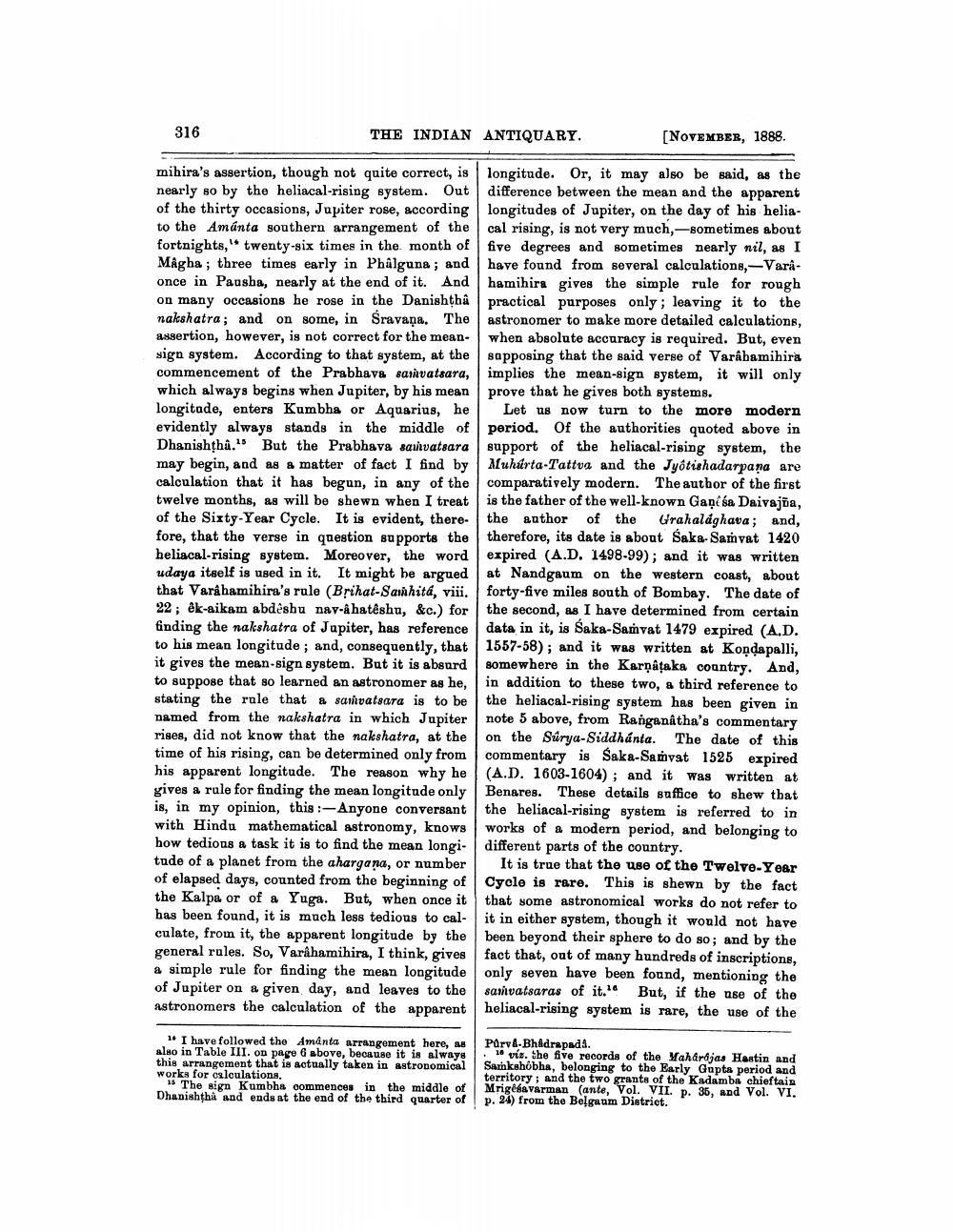________________
316
THE INDIAN ANTIQUARY.
[NOVEMBER, 1888.
mihira's assertion, though not quite correct, is longitude. Or, it may also be said, as the nearly so by the heliacal-rising system. Out difference between the mean and the apparent of the thirty occasions, Jupiter rose, accordinglongitudes of Jupiter, on the day of his heliato the Amánta southern arrangement of the cal rising, is not very much, --sometimes about fortnights," twenty-six times in the month of five degrees and sometimes nearly nil, as I MAgha; three times early in Phålguna; and have found from several calculations,-Varaonce in Pausha, nearly at the end of it. Andhamihira gives the simple rule for rough on many occasions he rose in the Danishthâ practical purposes only; leaving it to the nakshatra; and on some, in Sravana. The astronomer to make more detailed calculations, assertion, however, is not correct for the mean. when absolute accuracy is required. But, even sign system. According to that system, at the sapposing that the said verse of Varábamihira commencement of the Prabhava sarmvatsara, | implies the mean-sign system, it will only which always begins when Jupiter, by his mean prove that he gives both systems. longitude, enters Kumbha or Aquarius, he Let us now turn to the more modern evidently always stands in the middle of period. Of the authorities quoted above in Dhanishtha." But the Prabhava savatsara support of the heliacal-rising system, the may begin, and as a matter of fact I find by Muhirta-Tattva and the Jyotishadarpana are calculation that it has begun, in any of the comparatively modern. The author of the first twelve months, as will be shewn when I treat
is the father of the well-known Ganesa Daivajia, of the Sixty-Year Cycle. It is evident, there the author of the Grahalaghava; and, fore, that the verse in question supports the therefore, its date is about Saka-Samvat 1420 heliacal-rising system. Moreover, the word expired (A.D. 1498-99); and it was written udaya itself is used in it. It might be argued at Nandgaum on the western coast, about that Varahamihira's rule (Brihat-Sanhita, viii. forty-five miles south of Bombay. The date of 22; êk-aikam abdeshu nav-hatêshu, &c.) for the second, as I have determined from certain finding the nakshatra of Japiter, has reference data in it, is Saka-Samvat 1479 expired (A.D. to his mean longitude; and, consequently, that 1557-58); and it was written at Kondapalli, it gives the mean-sign system. But it is absurd somewhere in the Karnataka country. And, to suppose that so learned an astronomer as he, in addition to these two, a third reference to stating the role that a saivatsara is to be the heliacal-rising system has been given in named from the nakshatra in which Jupiter note 5 above, from Ranganatha's commentary rises, did not know that the nakshatra, at the on the Súrya-Siddhanta. The date of this time of his rising, can be determined only from commentary is Saka-Samvat 1525 expired his apparent longitude. The reason why he (A.D. 1603-1604); and it was written at yives a rule for finding the mean longitude only Benares. These details suffice to shew that is, in my opinion, this:-Anyone conversant the heliacal-rising system is referred to in with Hindu mathematical astronomy, knows works of a modern period, and belonging to how tedions a task it is to find the mean longi- different parts of the country. tude of a planet from the ahargana, or number It is true that the use of the Twelve-Year of elapsed days, counted from the beginning of Cycle is rare. This is shewn by the fact the Kalpa or of a Yuga. But, when once it that some astronomical works do not refer to has been found, it is much less tedious to cal it in either system, though it would not have culate, from it, the apparent longitude by the been beyond their sphere to do so; and by the general roles. So, Vardhamihira, I think, gives fact that, out of many hundreds of inscriptions, a simple rule for finding the mean longitude only seven have been found, mentioning the of Jupiter on a given day, and leaves to the samvatsaras of it. But, if the use of the astronomers the calculation of the apparent heliacal-rising system is rare, the use of the
1. I have followed the Amanta arrangement here, as Parva-Bhadrapads. also in Table III. on page G above, because it is always 1. 10 víz. the five records of the Mahardjas Hastin and this arrangement that is actually taken in astronomical Saunkshobha, belonging to the Early Gupta period and works for calculations,
territory; and the two grants of the Kadamba chieftain 15 The sign Kumbha commences in the middle of Mrigavarman (ante, Vol. VII. D. 36. and Vol. VI. Dhapishtha and ends at the end of the third quarter of p. 24) from the Belgaum Dietrict.




